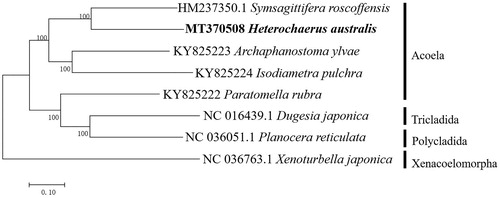Abstract
One complete mitochondrial genomes (mitogenomes) was determined for Heterochaerus australis (Acoela, Convolutidae). Its mitochondrial genome size was 13,885 bp. The sequence contains 2 ribosomal RNA genes (rrnL and rrnS), 20 tRNA genes, and 12 protein-coding genes (PCGs). The A + T content of the complete mitochondrial genome sequence was 70.8%. The base composition showed a tendency of high AT. The resulted maximum likelihood (ML) tree supported that Acoela had a distant relationship with other orders of Turbellaria and the Xenacoelomorpha.
The taxonomic status of Acoela of Turbellaria is controversial. Some researchers believe that the Acoela belongs to Deuterostomia and should be removed from the Platyhelminthes and combined with the Xenoturbella japonica to form the Phylum Xenacoelomorpha (Philippe et al. Citation2011; Cinar Citation2014). Jondelius et al. (Citation2011) interpreted the initial grouping of the Acoela and tunicates as a classical example of long-branch attraction (LBA). This is of particular relevance for Acoela species, which already demonstrate a very rapid rate of nucleotide substitution compared to other metazoans, leaving them vulnerable to LBA (Robertson et al. Citation2017). Here, we sequenced the mitochondrial genomes (mitogenomes) of Heterochaerus australis from Apostichopus japonicus breeding pond, and it has been indicated to be a new enemy species. In order to provide theoretical basis and scientific guidance for the taxonomic status of Acoela, mitochondrial gene composition, biological evolution, and molecular identification were studied.
Heterochaerus australis was collected from Dalian, Liaoning Province of China (39.22N, 122.18E) in 2019 from sea cucumber culture ponds. The specimen was deposited into Fishery Barcode Data Base of China (YSF-ZW-4634). Total DNA was extracted using Omega Mollusk DNA Kit. The genome was sequenced by BGISEQ-500 method. The type of sequencing was PE100 and the length of the inserted fragment was 250 bp. The remaining reads were assembled using NOVOplasty. ORF Finder (http://www.ncbi.nlm.nih.gov/gorf/gorf. html) and BLASTx were used to determine the protein-coding genes (PCGs) using the invertebrate mitochondrial genetic code. The positions of transfer RNA (tRNA) genes were localized by ARWEN (Laslett andCanbäck Citation2008) and DOGMA (Wyman et al. Citation2004) using the invertebrate mitochondrial genetic code and the default search mode.
The complete mitogenome sequences was 13,885 bp in length and has been deposited in the GenBank (Accession No. MT370508). The complete mitogenome contained 2 ribosomal RNA genes (rrnL and rrnS), 20 tRNA genes, and 12 protein-coding genes (PCGs). The A + T content of the complete mitochondrial genome sequence was 70.8%. The base composition showed a tendency of high AT. This phenomenon also appears in other species of Acoela (Mwinyi et al. Citation2010; Robertson et al. Citation2017).
Figure 1. Phylogenetic trees based on the concatenated nucleic acid of 12 protein-coding genes. The branch lengths are determined with ML analysis. Heterochaerus australis is shown in bold. Numbers above or below branches denote bootstrap percentages (1000 replicates). Genbank accession numbers are shown for published sequences.

A maximum likelihood phylogenetic tree of 7 species of Turbellaria and 1 species of Xenacoelomorpha was constructed based on the concatenated nucleic acid of 12 PCGs (). In Acoela, only one species (P. rubra) clustered with other orders of Turbellaria, while the other four species (A. ylvae, I. pulchra, H. australis, S. roscoffensis) clustered into a single cluster, showing a distant relationship with other turbellarian. But X. japonica of Xenacoelomorpha is a separate branch.
Disclousure statement
No potential conflict of interest was reported by the author(s).
Data availability statement
The data that support the findings of this study are openly available in NCBI GenBank (https://www.ncbi.nlm.nih.gov/) with reference number [MT370508].
Additional information
Funding
References
- Cinar ME. 2014. Checklist of the phyla Platyhelminthes, Xenacoelomorpha, Nematoda, Acanthocephala, Myxozoa, Tardigrada, Cephalorhyncha, Nemertea, Echiura, Brachiopoda, Phoronida, Chaetognatha, and Chordata (Tunicata, Cephalochordata, and Hemichordata) from the coasts of Turkey. Turk J Zool. 38(6):698.
- Jondelius U, Wallberg A, Hooge M, Raikova OI. 2011. How the worm got its pharynx: phylogeny, classification and bayesian assessment of character evolution in Acoela. Syst Biol. 60(6):845–871.
- Laslett D, Canbäck B. 2008. ARWEN: a program to detect tRNA genes in metazoan mitochondrial nucleotide sequences. Bioinformatics. 24(2):172–175.
- Mwinyi A, Bailly X, Bourlat SJ, Jondelius U, Littlewood DTJ, Podsiadlowski L. 2010. The phylogenetic position of Acoela as revealed by the complete mitochondrial genome of Symsagittifera roscoffensis. BMC Evol Biol. 10(1):309.
- Philippe H, Brinkmann H, Copley RR, Moroz LL, Nakano H, Poustka AJ, Wallberg A, Peterson KJ, Telford MJ. 2011. Acoelomorph flatworms are deuterostomes related to Xenoturbella. Nature. 470(7333):255–258.
- Robertson HE, Lapraz F, Egger B, Telford MJ, Schiffer PH. 2017. The mitochondrial genomes of the acoelomorph worms Paratomella rubra, Isodiametra pulchra and Archaphanostoma ylvae. Sci Rep. 7(1):1847.
- Wyman SK, Jansen RK, Boore JL. 2004. Automatic annotation of organellar genomes with DOGMA. Bioinformatics. 20(17):3252–3255.
